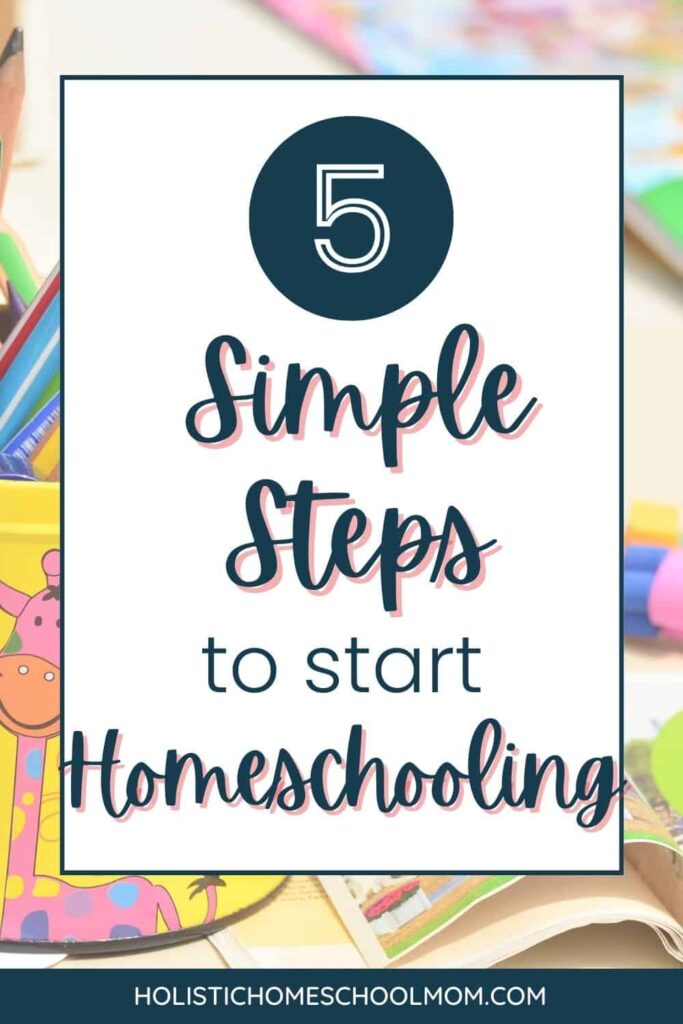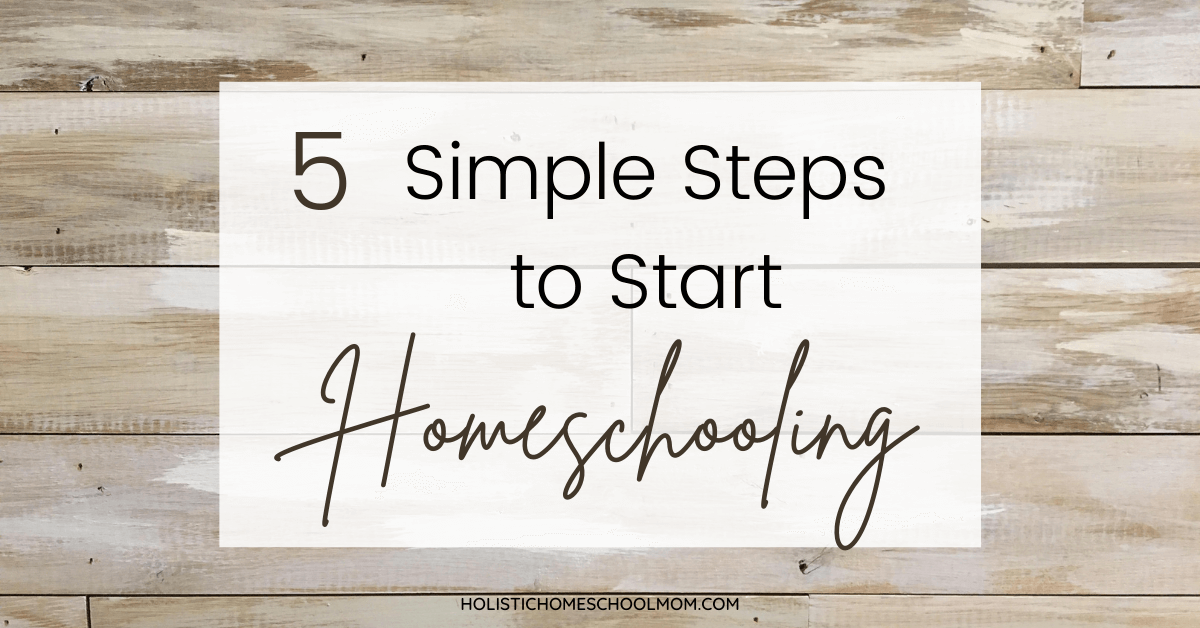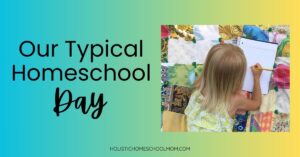Uncertain. Overwhelmed. Confused. Those were a few of the feelings I experienced once I decided I wanted to start homeschooling. I knew that homeschooling was a thing, and that this was the route I wanted to take. Unfortunately, I didn’t really know anyone who homeschooled at the time, and I certainly didn’t know any steps for how to start homeschooling.
Can you relate?
Perhaps you don’t know any homeschoolers. Perhaps you do, but the thought of getting started is looming large.
It’s not a particularly easy task to undertake if you think about it. You are now fully responsible for your child’s education. There is a bit of a learning cure involved! If you’re like me, I didn’t even know what exactly a kindergartener should learn .
How much math? What books do I use? Do I even need books?
Besides the considerations of all the nuts and bolts like materials and books, I like to have a little bit of a plan. Not a fully-detailed, intricate plan, but at least some idea of where I am headed and where I want to end up. I like to know my options before I start, and I’m more than a little afraid to make mistakes.
Know anyone like that?
If you find yourself in the same position I was in so many years ago, I know these 5 Simple Steps to Start Homeschooling will give you a launching point for your journey.
Rest easy that you are quite capable of doing this homeschooling gig. While it will be challenging or possibly even one of the hardest things you’ve ever done, your children are joining the ranks of approximately 2.5 million other homeschooled students.
You aren’t alone. You got this!

How To Start Homeschooling In Five Simple Steps
1-Discover Your State’s Legal Requirements
Every state has its own mandates and rules for homeschooling. The easiest place to begin is with the Home School Legal Defense Association website. There you will discover what is required in your particular state, as well as many of your rights as a homeschooler.
2-Utilize the Knowledge Of Friends, Blogs and Books
Get in contact with any friends, family, or even acquaintances that you know already homeschool. They will be a wealth of information to you.
Here are important questions to ask about homeschooling:
- What curriculum do you use and how do you like it?
- What does your typical homeschool day look like?
- What are your greatest challenges as a homeschooler?
- Where do you find resources that help you homeschool?
Most homeschoolers are more than happy to have you over, show you their homeschooling spaces, let you browse through their curriculum, and talk about their successes and failures.
Also, be sure to check out a few homeschooling books. Many will address the basics of homeschooling, and help build your confidence and understanding of the heart of homeschooling. My Top 5 Homeschooling Book Picks are great titles that will help get you started.
Lastly, homeschooling blogs (like this one!) will be your friends. There are so, so many to choose from. You can find everything from explanations of different homeschooling approaches, to free resources, to articles helping you pick curriculum and plan a schedule.
3-Investigate Homeschooling Approaches
There are many different approaches to homeschooling. This basically refers to the lens in which you view and operate your homeschool. It influences what curriculum you choose (or don’t choose), and how you will shape your homeschooling environment.
I personally lean towards a Charlotte Mason approach. To be brief, this means that we use living books and high quality literature to learn our various subjects. We also regularly include nature study, art and poetry, and utilize the practices of narration and dictation.
As you read about the different approaches and talk with others about what approach they use, you will probably find yourself resonating with a particular one, or pieces of several different methods.
While it’s not necessary to subscribe to any particular method, as you homeschool you will understand what works well for you and your kids. It will become clearer what approach you identify with the most.
If you resonate with the Classical approach, for example, then you can use that as a starting point for what curriculum you might choose, what blogs you might follow, and what further reading and research you’d like to do.
I suggest you read more about how to find your homeschooling method. When you discover your family’s homeschool style it will help you further develop your homeschool life.
4-Choose a Homeschool Curriculum
Eventually, you will need to decide what materials your students will use. It can be easy to get overwhelmed at this point. It’s best to start simply.
There are many expensive curriculums that can provide everything you need for every subject. Often referred to as an all-in-one curriculum, it is convenient and eliminates making a decision about each subject. However, you can figure out ways to cover every subject by using only free resources as well. The choice is yours.
I use a combination of free and purchased items. I also borrow a whole lot of books from the library. Sometimes I swap with friends. Ultimately, I plan a budget for my year, and try to stick to it.
There is no right or wrong here, but once you decide what subjects you want to cover, you can look into online reviews, or just go with what a friend recommends and get started.
Don’t get stuck in analysis paralysis!
5-Make a Homeschool Schedule Or Routine
Okay, so you know what your state requires, you’ve learned a bit about homeschooling from friends and great resources, and you have any materials you need all ready to go.
Now what?
At this point, try to establish what your typical day might look like. This can be a basic schedule for your day or a general routine you want to follow. Keep it simple, be flexible, and give it a try. No two family’s schedules are alike.
In our home, my kids officially need to be doing that day’s assignments by 8:30am. However, since they wake up by 7:00 and love to get a head start, they often already start school long before 8:30.
I don’t schedule their every waking moment. They have a list of what needs done, and I allow them a good deal of flexibility as to when and how they choose to accomplish it.
If something isn’t working, you can always rework things. With time, you will find your groove.
You can find out more about Our Typical Homeschool Day to help you consider a structure for your own.

It Doesn’t Have to Be Perfect
So that’s it! 5 Simple Steps to Start Homeschooling!
My last piece of advice: don’t worry about making everything perfect.
Maybe you don’t start off the year knowing how you’ll handle your science learning, but you have math and spelling down. That’s good! Start there, and keep adding.
It’s one of the beauties of homeschooling. It will all come together. As with most things, if you wait until it’s perfect, you’ll never get started.
Please reach out if you have specific questions about your homeschool journey. I’d love to answer any questions you may have! You can leave a question in the comments or reach out to me on the contact page.




